Musical Architecture: Two Bandstands in St. Paul
Glenn Gordon, on his peregrinations through the city, noticed these two structures, seemingly made for the purpose of distinguishing good design from bad. Here are his thoughts on the matter, the first in an occasional series on design.
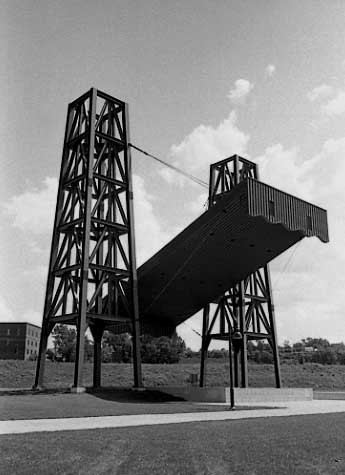
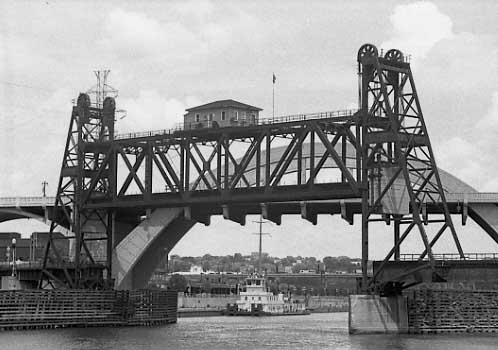
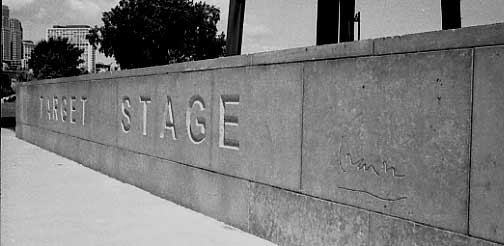
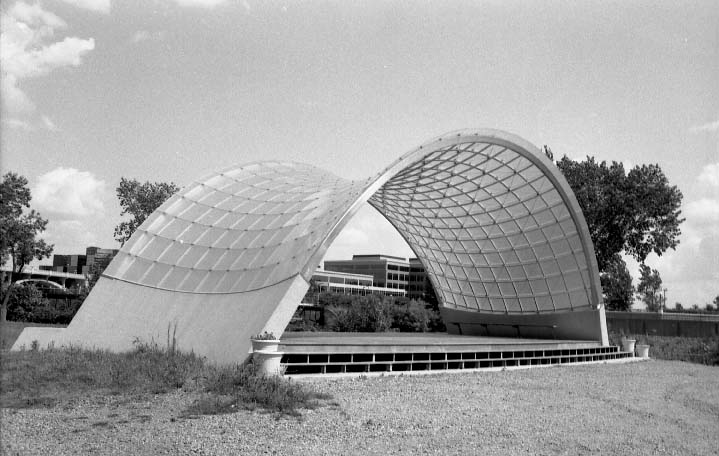
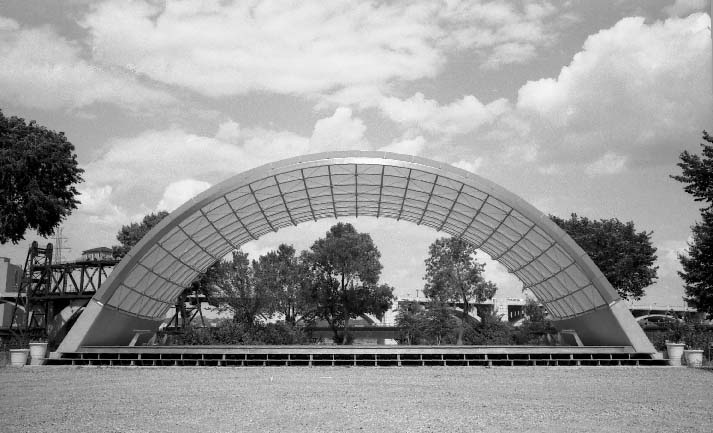
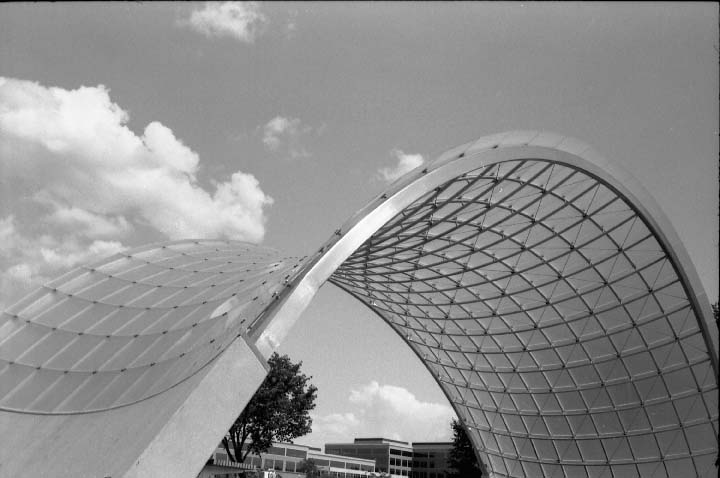
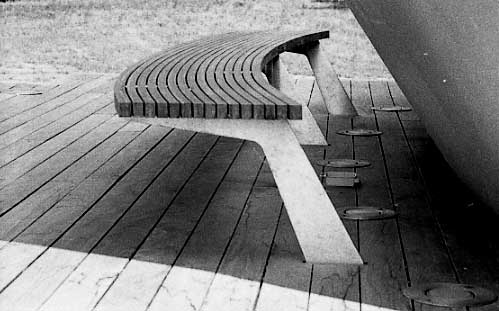
By coincidence, there are two relatively new bandstands sitting less than a thousand yards apart near the river in downtown St. Paul. One, the Heilmaier Memorial Bandstand, is on Raspberry Island, a neglected little spit of land in the middle of the river below the Wabasha Street Bridge. The other, the Target Stage, is on the southern edge of the broad greensward of Harriet Island Park. One is a work of great poetry. The other, by the celebrated architect and designer Michael Graves, is an eyesore.
Graves’ Target Stage, a “gift” from the Target Corporation to the people of St. Paul, is the kind of gift that, as soon as you get it, you start looking for ways to get rid of it. Implicit in a gift like this, however, is the expectation that the simple folk of St. Paul prostrate themselves with gratitude not only for Target’s generosity but for Graves consenting to give us anything at all. Since Minnesotans are mortified of being thought in any way “critical” or “negative,” good manners require us to lap up whatever is set before us. In the face of celebrity, we are not merely bovine, we are cowed, and therefore probably stuck with this monumentally ugly necktie till it rusts away.
The aisles of Target stores are piled high with the fruit of Michael Graves’ thinking about design: fun hamburger flippers, twee teakettles, chubby toasters, and toilet bowl brushes with rubbery turd-shaped handles. All these objects (there are almost 300 of them) whimsically “democratize” design so that now, thanks to the architect’s feeling for the little people, the humblest home in America can have a shot at the elegance of Pee-Wee’s Playhouse.
Graves’ Target Stage is whimsy gone berserk—it looks like a gallows. The stage consists of a raised concrete platform flanked by a pair of looming, oil–derrick-like steel towers. Suspended by cables at an angle front-to-back between these towers is a skimpy canopy that looks like a shop awning or a piece of cupcake paper with a wavy bit of trim at the edge, this trim apparently meant to symbolize musical gaiety or the shape of a sound wave or a slice of bacon or the wiggly Mississippi River nearby, or some damned thing. Graves would have done better to suspend a gigantic Target credit card between a colossal pair of shopping carts–it would have been more honest. His towers are evidently meant to quote the skeletal industrial structure of the old railroad lift bridge a few hundred yards downriver. The bridge’s cross-braced steel towers powerfully but matter-of-factly express or diagram the forces acting on them. They embody the job they were engineered to do. Graves’ reference to them, however, is empty and perfunctory, and visually inept. Goethe’s observation that “Architecture is frozen music” seems to
have fallen on a tin ear.
The other salient feature of Graves’ stage, the apron, is faced with panels of native Mankato stone–a beautiful material, applied here, however, like pancake makeup, with the words, “TARGET STAGE” carved in foot-high letters incised an inch deep, staring the audience in the face. A panel to the right of this is carved with a simulation– greatly enlarged–of the architect’s scrawled signature, putting all who gaze upon it on permanent notice that what we have here is no ordinary piece of building, but a signed canvas, a veritable work of art.
A quarter of a mile downstream, meanwhile, is the Heilmaier Memorial Bandstand on Raspberry Island, designed by the architect and glass artist James Carpenter. Carpenter was one of the finalists for the commission several years back to design the new Wabasha Street bridge. His bold proposal for a bridge centrally suspended from a soaring, V-shaped mast was rejected as too daring, too “modern,” too “different,” and probably too expensive, though that we’ll never know. The only part of Carpenter’s proposal that survived–the Raspberry Island bandstand– is our consolation prize. A jewel almost lost in the weeds of redevelopment, its elegance is a rebuke to the pointlessly busy detailing of the bridge that eventually got built, and to the programmatic mediocrity of so much of the rest of the St. Paul riverfront’s redevelopment, from the uninspired, pharmaceutically named “Centex Homes” townhouses upriver on Shepherd Road to the boring corporate campuses across the river from downtown.
The Heilmaier bandstand is an architectural folly in the best sense of the word, a work of fancy, both ridiculous and sublime. From the standpoint of flatfooted practicality you could say it’s nearly useless, but on another level it’s a deeply necessary thing, a lyric structure that sings to the eye and to the heart; a materialization—a shockingly beautiful one–of music itself. It is an acoustical portal, a cornucopia for music to spill out of.
In the language of topology, the overall form of the Heilmaier shell is a hyperbolic paraboloid, which is to say, it’s shaped like a saddle. From certain angles, its curves look like the wave patterns on the screen of an oscilloscope. Like the instruments of a chamber group, each material in the structure has a distinct voice, clearly articulated from the others. The palette is simple–steel, glass, concrete, and wood–but this puts it too simply. The steel is stainless steel, carefully machined. Each of the sandblasted glass panels is actually a face-to-face lamination of two pieces of glass, which influences how light is refracted. The wood–identified as “ironwood”—-is a species resistant to the weather, like teak. The massive pair of canted, prefabricated concrete buttresses was formed with close attention to the fairness of the curves.
Whichever detail of the structure the eye lights upon, the workmanship is uncompromised: the precision of the steel fabrication, the specially designed hardware, the finish of the concrete, the way the planks of the stage have been laid—everywhere you turn there is a sense of craft consciously brought to bear, and of the pleasure the builders were taking in their work. But there is nothing precious in the workmanship; it isn’t there for its own sake but to serve the composition of the structure as a whole.
Roofed in glass, but open to the weather, the bandstand lets in not only light and air but water, in just about every form, from rain, snow, sleet, icicles, and hail to the rising waters of the river when it floods. On sunny days, the canopy’s panels of laminated, translucent glass–each one a facet oriented at a slightly different angle to the continually shifting position of the sun–refract rainbows onto the floor of the stage, rainbows that will at certain moments, when the sun’s in the right spot, spill onto musicians as they perform.
Tucked under the canopy, close and parallel to the concrete buttress on either side of the stage, is a bench, the swooping curve of its laminated wood seat dramatically cantilevered off slender boomerang-shaped steel supports that seem to grow right out of the stage floor.
Porous to the light and to the waters that can comb through it, the Heilmaier bandstand transcends the sorry current condition of its site. Last summer, weeds were growing around it and the area was strewn with litter. Plastic pop bottles and the shreds of disemboweled sleeping bags abandoned by homeless people lay around the dirt and gravel lot, which is still waiting to be landscaped.
Former Mayor Norm Coleman used to make it sound as though “bringing hockey to St. Paul” in the Xcel Arena just upstream were a feat equal to causing the waters to spring forth and the desert to bloom. The Heilmaier Bandstand, meanwhile, surely one of the most beautiful works of public art ever built in the Twin Cities, seems to have gotten lost in the shuffle for the puck and the rush to get a Peanuts figure plopped down everywhere you look. Even unlandscaped, however, James Carpenter’s Heilmaier Bandstand, its roof diaphanous as a summer moth, is an embodiment of musical fluidity. By comparison, Michael Graves’ Target Stage oppresses the ground it stands on. Let’s hope that Graves’ current project in the Cities, the addition to the Minneapolis Institute of Arts, is done with greater feeling for the art it is supposed to shelter.
All photos courtesy Glenn Gordon. As always, click on photos to enlarge.